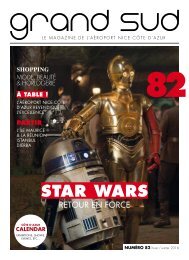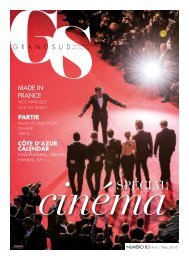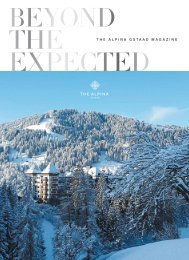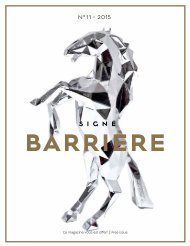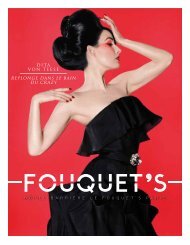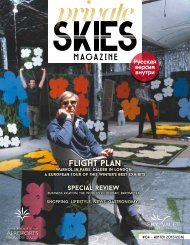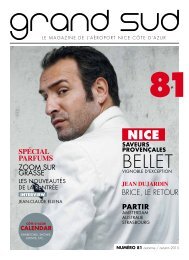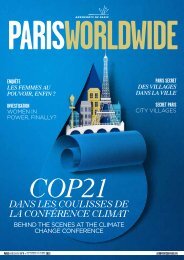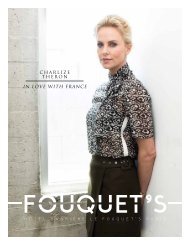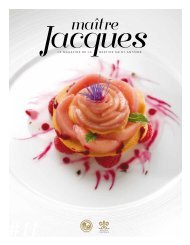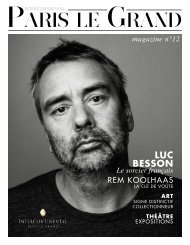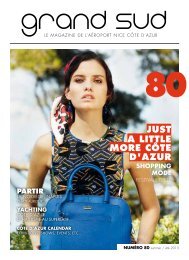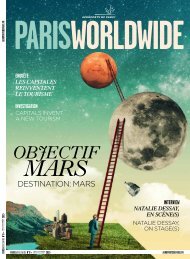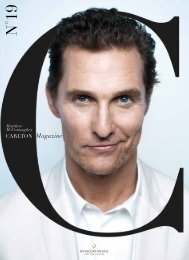GH13_issuu
You also want an ePaper? Increase the reach of your titles
YUMPU automatically turns print PDFs into web optimized ePapers that Google loves.
© Jochen Littkemann, Berlin<br />
world. His desire to foster awareness in a<br />
country pinpointed for the atrocities of the<br />
concentration camps was the catalyst for an<br />
entire reflection revolving around Germanic<br />
myths and the mourning of Jewish culture.<br />
pour changer la politique, mais pour<br />
me changer moi-même – et j’ai puisé<br />
dans les mythes pour exprimer mon<br />
émotion. C’était une réalité trop lourde<br />
pour être réelle, il fallait passer par le<br />
mythe pour la restituer. » D’où une<br />
immense impression de désolation<br />
dans ses gigantesques installations et<br />
tableaux aux architectures urbaines<br />
apocalyptiques. Une représentation<br />
du désastre où s’amoncellent, dans<br />
un chaos énigmatique, sable, terre,<br />
cendre, végétaux, brique, écriture,<br />
pigments, cheveux ou encore feuilles<br />
de plomb, qu’il a récupérés de la toiture<br />
de la cathédrale de Cologne lors des<br />
multiples restaurations. Tout ce fatras<br />
cataclysmique est baigné de poésie. Une<br />
inspiration majeure qu’il dédie depuis<br />
les années quatre-vingt-dix à l’influence<br />
Innenraum [Intérieur], 1982<br />
Aquarelle, crayon et collage. 77,5 x 68,5 cm<br />
Hall Collection<br />
de trois poètes, Paul Celan, Ingeborg<br />
Bachmann et Velimir Khlebnikov,<br />
trois auteurs faisant front contre l’oubli<br />
et la barbarie. À travers ses « Maisons »<br />
effondrées, qu’il conçoit depuis 1993,<br />
et ses herbiers géants, Anselm Kiefer<br />
oppose la fertilité de la nature à la folie<br />
destructive des hommes. Les théories du<br />
philosophe mystique Robert Fludd et les<br />
écrits de la Kabbale se sont également<br />
emparés de son œuvre dès 2000, dans une<br />
exposition intitulée Chevirat Hakelim<br />
au cœur de la chapelle de l’hôpital de<br />
la Salpêtrière. La singulière intensité<br />
plastique et visuelle de son œuvre, liée à<br />
une profonde réflexion sur la condition<br />
humaine, nous guide inexorablement<br />
vers nos propres retranchements, ceux<br />
de la mémoire.<br />
TIME, HISTORY AND MATTER<br />
The memory theme is omnipresent in<br />
Kiefer’s work. «If you want to know<br />
yourself», he says «you have to know your<br />
people and history… So I dived into History<br />
and woke up memories – not to change<br />
politics, but to change myself – and I delved<br />
into myths to express my emotion. The<br />
reality was too heavy to be real, I needed to<br />
use mythology to render it.» That is why his<br />
gigantic installations and paintings, with<br />
their apocalyptic urban architectures, give<br />
an immense impression of desolation. In his<br />
representations, sand, soil, ashes, plants,<br />
bricks, writing, pigments, hair and leaves<br />
of lead retrieved from the roof of Cologne<br />
Cathedral during its multiple refurbishment<br />
works are heaped together to form an<br />
enigmatic chaos. But this cataclysmic<br />
hotchpotch is bathed in poetry - a major<br />
inspiration since the Nineties owed to the<br />
poets Paul Celan, Ingeborg Bachmann<br />
and Velimir Khlebnikov: three authors<br />
united against oblivion and barbarianism.<br />
Through the collapsed «Houses» he has<br />
been designing since 1993 and his giant<br />
herbariums, Anselm Kiefer opposes the<br />
fertility of nature and the destructive<br />
madness of mankind. The theories of the<br />
mystical philosopher Robert Fludd and<br />
writings from the Kabbalah have also taken<br />
hold in his work since 2000, as witnessed<br />
by his exhibition entitled Chevirat Hakelim<br />
held at the Pitié-Salpêtrière Hospital chapel.<br />
The singular plastic and visual intensity<br />
of Kiefer’s work, intrinsically linked to a<br />
deep reflection on the human condition,<br />
inexorably drives us into the corner of our<br />
own memories.<br />
Ouroboros, (détail) , 2014<br />
Verre, métal, plomb, feuilles séchées<br />
et plastique. 132 x 90 x 60 cm<br />
Collection particulière<br />
© Georges Poncet<br />
COVER STORY/ 52



